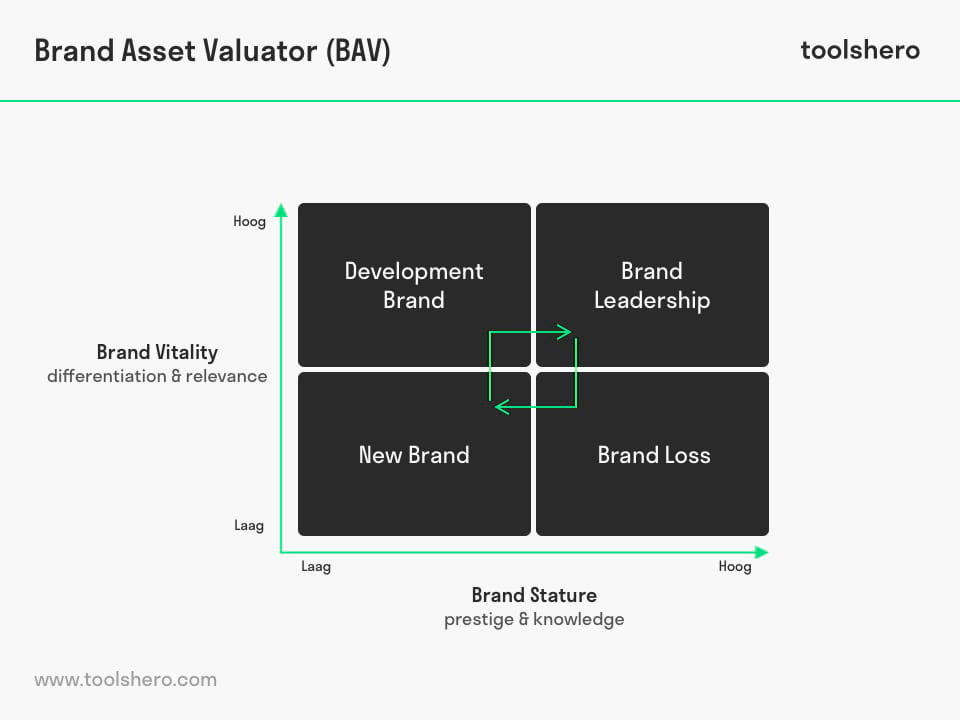Brand Asset Valuator Model and Template

Brand Asset Valuator model: this article provides a practical explanation of the Brand Asset Valuator (BAV) model. This article contains the general definition of the Brand Asset Valuator, the BAV matrix and a downloadable questionnaire. After reading, you will understand the basics of this brand management and marketing tool. Enjoy reading!
What is Brand Asset Valuator (BAV)?
A quality brand name is important for organisations; with a strong brand name, their products and/or services are recognised by (potential) customers, suppliers, and other parties. All these groups will directly link the brand name with a certain level of quality, assurance, and service.
It is exactly for this reason that large and reputable top brands perform better than smaller, unknown brands.
The Brand Asset Valuator Power Grid of the leading American communication agency Young & Rubicam includes four quadrants, depicting brands and their development.
The Brand Asset Valuator measures brand value and the ability of a brand keep its customers happy by staying relevant in the market.
Using this quadrant, one can determine whether a brand is strong or not and what the consequences are for the turnover of the product and / or services. In other words, the Brand Asset Valuator (BAV) measures the strength and growth potential of brands and brand names.
The model is based on the ImagePower model of the American design agency Landor Associates.
In the 1980s, they used this model to indicate that, when it comes to brands names, a distinction should be made between ‘Esteem Index’ and ‘Share-of-mind Index’, in which ‘esteem’ refers to the consumer’s appreciation for a certain brand and ‘share-of-mind’ to the level of brand recognition.
Main Dimensions
In the Brand Asset Valuator (BAV), the added value of a specific brand is viewed from the consumer’s perspective. It takes a lot of time and energy to build strong brand names.
Strong brand names add value to a product and/or service, through which an organisation can distinguish itself from competitors. In measuring the value of a brand, Brand Asset Valuator (BAV) consists of two dimensions:
1. Brand Vitality
Brand Vitality indicates the brand strength; this is the growth potential of the brand and consists of two variables:
Differentiation
To what extent is the brand unique compared to others?
Relevance
Does the brand respond to the personal need of the consumer?
2. Brand Stature
Brand Stature as the name suggests, indicates the brand’s overall prestige; it reflects the current brand strength (stature) and consist of the following two variables:
Esteem
Does the brand ensure the needs and wishes of consumers are satisfied?
Knowledge and Understanding
How familiar are consumers with the brand and do they understand the brand dentity?
The variables Appreciation and Knowledge are directly derived from the aforementioned ImagePower model.
Brand Management: Build Successful Long Lasting Brands
Brand Asset Valuator Variables
The aforementioned variables are explained further below:
1. Differentiation
A successful brand will have to stand apart from its competitors. This differentiation must be unique as well as different from competitors; it must propagate the vision and mission of the organisation, while at the same time be distinctive.
The more powerful a brand name, the higher the price an organisation can sell the product for. This explains how top brands charge relatively higher prices than lesser known brands.
2. Relevance
Within the Brand Asset Valuator (BAV), this is about the relevance the brand name has for the consumer. To what extent does the brand respond to the needs, wishes, and requirements of the consumer?
In addition to their basic needs, consumers often want a tailor-made product that meets all their specific requirements. Think of price-quality ratio, service, functionality, user-friendliness, shape, regular customer promotions, and so on.
The better organisations are aware of the consumer’s wishes and requirements, the more they can associate these with their brand name and thus attract customers. After all, the consumer perception is what makes or breaks a brand.
3. Esteem
Consumers often connect a certain image with a product or brand. This is also referred to as emblem communication. It ensures a Louis Vuitton bag holds more prestige than a bag from an unknown brand.
A brand name’s esteem is linked to the conformity of a group of users. As soon as the brand meets the expectations of a larger group, it will give the consumer additional prestige within this group.
4. Knowledge
Consumers will make a conscious decision to buy a certain brand as soon as they know what it stands for. Organisations place great importance on propagating their mission and vision in the knowledge that this will determine their image through the brand. Knowledge of the brand is part of this.
Brand knowledge and brand awareness therefore play a great factor in the growth of brand value.
Brand Value example Apple
The brand equity of Apple was set at $612 billion in 2020. Apple’s brand value has been able to reach this astronomical height because of the brand’s relentless focus on keeping their customers happy. They have managed to do this through their high quality hardware and proprietary software. The products are sold in stylish shops that have a luxury image.
The brand has always appealed to the premium segment of the consumer electronics market with innovative and interesting new products.
For example, the Apple Watch was launched in the premium category, as well as other products in different price ranges. Thus, Apple as a brand became available to a wide audience ranging from luxury accessories, IT solutions, music streaming services etc.
The most valuable asset of the brand remained the iPhone.
Brand Asset Valuator Questionnaire
The Brand Asset Valuator questionnaire is effective for valuing the brand value of a (small) organisation.
It contains various elements that make it possible to measure the value of assets. The data that comes from completing the questionnaire helps managers determine how they can increase the value of their brand or organisation in the future.
Download the Brand Asset Valuator Questionnaire
This template is exclusively for our paying Toolshero members. Click here to see if a membership is something for you!Brand Asset Valuator quadrants
In applying the Brand Asset Valuator (BAV), a grid consisting of four quadrants is created. By addressing these four quadrants, companies can build and maintain a brand name. Each quadrant indicates a degree of brand awareness. At the basis of the model are Brand Vitality on the Y-axis and Brand Stature on the X-axis. The Y-axis shows to what extent Relevance and Differentiation are either low or high. The X-axis shows the same for Esteem and Knowledge. All combinations result in the following four quadrants:

Figure 1 – Brand Asset Valuator Matrix
New Brand
The Brand Vitality and Brand Stature are both low. The new product or service may already be distinctive, but not yet known to consumers. Marketing is required to get the brand in the minds of consumers and to convince them to give the new product a try.
Development Brand
The Brand Vitality is high and the Brand Stature is low. The brand is distinctive enough with regard to competitors, but more awareness needs to be generated. This is done through promotional activities and information transfer.
Brand Asset Valuator and Brand Leadership
The Brand Vitality and Brand Stature are both high, which means the highest goal has been achieved. One can speak of a top brand that is popular among consumers and has significant sales. It is wise for companies to do all they can to maintain this status. A name change isn’t a good idea here, and neither is a rigorous change of the product or service. After all, the customer relies on the brand.
Brand Loss
The Brand Vitality and Brand Stature are both low. This may be due to various factors. Changes in the environment, new developments and trends, and scandals and negative publicity; they can all bring a brand to the edge of the abyss. Competitors have taken over the market and the organisation will have difficulty returning to their previous position.
Brand Asset Valuator and Loyalty
Using the Brand Asset Valuator (BAV), one can give an indication of a brand’s market position. Organisations can create their brand policy by analysing the environment and implementing an appropriate strategy. For example, the brand name can further be expanded upon by means of a marketing campaign, improving the market position even further.
The stronger the brand, the more familiar it will be among potential customers and the more appreciation it will evoke. This ensures consumers become loyal to a specific brand, as a result of which they will make repeat purchases.
They’ll have a positive impression of the brand and experience with it, and they will likely share these with others. Generally speaking, loyal consumers have gone through all stages and are now more or less fans of ‘their’ brand. However, there is always the danger that consumers will get bored with a brand. In other words, organisations must continuously work on building their brand proposition.
Now it’s your turn
What do you think? Are you familiar with Brand Asset Valuator (BAV)? What are your experiences with Brand Asset Valuator (BAV) within your organisation? Do you have any tips or additions?
Share your experience and knowledge in the comments box below.
More information
- Costa, R., & Evangelista, S. (2008). An AHP approach to assess brand intangible assets. Measuring Business Excellence, 12(2), 68-78.
- de Mortanges, C. P., & Van Riel, A. (2003). Brand equity and shareholder value. European management journal, 21(4), 521-527.
- Oxford Learning Lab (2019). Brand Management: Build Successful Long Lasting Brands. Retrieved 01/12/2024 from Udemy.
- Marcus, A. (2004). Branding 101. interactions, 11(5), 14-21.
How to cite this article:
Mulder, P. (2021). Brand Asset Valuator model. Retrieved [insert date] from Toolshero: https://www.toolshero.com/marketing/brand-asset-valuator-bav/
Original publication date: 03/14/2021 | Last update: 01/12/2024
Add a link to this page on your website:
<a href=”https://www.toolshero.com/marketing/brand-asset-valuator-bav/”>Toolshero: Brand Asset Valuator model</a>













One response to “Brand Asset Valuator Model and Template”
BAV Power Grid does not only help in evaluating / auditing and then mending deficiencies in the brand but can also be helpful when a brand has to be acquired by another entity , especially in a Pluralistic Brand Architecture where it stands alone . The advantages and the disadvantages can be observed accordingly for devising future marketing strategy .